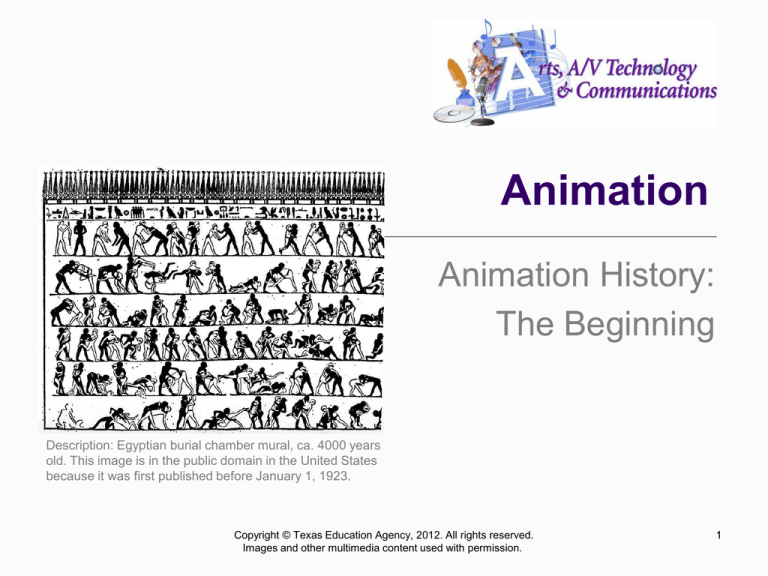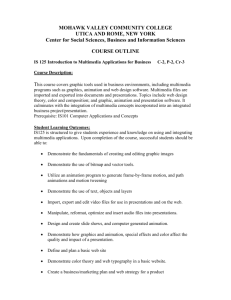
Animation
Animation History:
The Beginning
Description: Egyptian burial chamber mural, ca. 4000 years
old. This image is in the public domain in the United States
because it was first published before January 1, 1923.
Copyright © Texas Education Agency, 2012. All rights reserved.
Images and other multimedia content used with permission.
1
Thaumatrope [thaw-muh-trohp]
Device created in 1827 by English physician John
Ayerton Paris which has two different drawings on
opposite sides of a disk. When the disk is spun, the
images merge into one.
Paul Roget used the thaumatrope in 1828 to
demonstrate his persistence of vision concept.
Copyright © Texas Education Agency, 2012. All rights reserved.
Images and other multimedia content used with permission.
2
Other Animation
Inventions
These images of phenakistoscopes are in the public
domain because their copyright has expired.
Phenakistoscope
(Phen`a*kis"to*scope),– A
circular card with slits around
the edge. Viewer held card
up to a mirror and peered
through the slits as the card
whirled. A series of
progressive drawings created
a moving object.
Zeotrope – A similar device
with progressive drawings on
the inside of a drum-like
cylinder.
Copyright © Texas Education Agency, 2012. All rights reserved.
Images and other multimedia content used with permission.
3
Photography
Animation on film only possible
because of invention of photography in
1827 by Joseph Niépce.
Louis Daguerre, an assistant to
Niépce, develops a new process for
developing images in 1837 (tin-type
photos).
During the American Civil War (18601865), New York photographer
Matthew Brady becomes well-known
by taking photos of the war.
In 1885, George Eastman introduced
transparent, flexible film and in 1888
marketed his Kodak camera, bringing
photography to the average American.
Joseph Nicéphore Niépce, n.d.
This image is in the public domain because
its copyright has expired.
Copyright © Texas Education Agency, 2012. All rights reserved.
Images and other multimedia content used with permission.
4
Eadweard J. Muybridge
Eadweard J. Muybridge, n.d.
This image is in the public domain because
its copyright has expired.
Well known as a photographer in
California, Muybridge is hired by
former governor Leland Stanford
to photograph the governor’s race
horse. Stanford has a wager that
all four hooves of a horse leave
the ground when running.
Muybridge’s job is to prove the
theory.
Using twenty-four cameras, a
system of trip shutters, and high
speed film, Muybridge’s series of
still photographs give the
impression of motion.
Copyright © Texas Education Agency, 2012. All rights reserved.
Images and other multimedia content used with permission.
5
Eadweard J. Muybridge
Image from the Smithsonian Institute and used in accordance with their copyright
guidelines.
http://americanhistory.si.edu/muybridge/htm/htm_sec1/sec1.htm
http://www.si.edu/copyright/
Copyright © Texas Education Agency, 2012. All rights reserved.
Images and other multimedia content used with permission.
6
Thomas Edison
America’s premier inventor, Thomas
Alva Edison, who invented the light
bulb and the phonograph, develops a
motion picture camera (the
kinetograph) and a projector (the
kinetoscope) in 1891.
Auguste and Louis Lumiere credited
with first motion picture public
screening in 1895.
In 1903, the landmark silent movie Thomas Edison with Kinetoscope, 1912
from the Smithsonian Institute and used
“The Great Train Robbery” debuted. Images
in accordance with their copyright guidelines.
It was created by former Edison
cameraman Edwin S. Porter, was a
commercial success, and lead to the
rise of western movies.
http://www.americanhistory.si.edu/edison/ed_d.htm
http://www.si.edu/copyright/
Copyright © Texas Education Agency, 2012. All rights reserved.
Images and other multimedia content used with permission.
7
J. Stuart Blackton
Blackton started as a vaudeville
performer known as “The Komikal
Kartoonist” who drew lightning-fast
sketches.
After meeting Edison, Blackton
became interested in putting his
drawings on film. He formed one of
the first film studios, the Vitagraph
Company.
In 1906 using a chalkboard,
Blackton created “Humorous Phases
of Funny Faces” which is known as
the first animated film.
James Stuart Blackton, 1912
This media file is in the public domain in
the United States.
Copyright © Texas Education Agency, 2012. All rights reserved.
Images and other multimedia content used with permission.
8
Winsor McCay
McCay works as a cartoonist for several
newspapers.
In 1911, McCay animates “Little Nemo”
and in 1912 animates “How a Mosquito
Operates.”
In 1914, McCay brings “Gertie the
Dinosaur” to life on film. It is included in
his vaudeville act along with camera
tricks where McCay appears on screen
with Gertie. Gertie is regarded as the
first successful cartoon character who
paved the way for Felix the Cat, Betty
Boop, Mickey Mouse, and Bugs Bunny.
Uses animation to illustrate the “Sinking
of the Lusitania” in 1918.
Copyright © Texas Education Agency, 2012. All rights reserved.
Images and other multimedia content used with permission.
This image is in the public
domain because its copyright has
expired.
9
Celluloid
From 1914 through 1920, several film and
animation houses were started in New
York.
The John Bray Studio proved to be one of
the most influential of the early studios
with its cartoon series, “Colonel Heeza
Liar.”
Bray employee Earl Hurd invents the
process of inking the animator’s drawings
onto clear pieces of celluloid and then
photographing them in succession on a
single painted background. This
development in late 1914 simplified the
animation process.
Copyright © Texas Education Agency, 2012. All rights reserved.
Images and other multimedia content used with permission.
10
Otto Messmer
In 1919, Otto Messmer created
Felix the Cat for the Pat
Sullivan Studios.
Unlike Winsor McCay’s Gertie
the Dinosaur, Felix the Cat was
a studio character. This meant
that audiences could look
forward to seeing him again and
again. Felix was also exposed
to audiences across the
country.
Copyright © Texas Education Agency, 2012. All rights reserved.
Images and other multimedia content used with permission.
11
Walt Disney
In 1923, became the first major
animation studio to relocate to
Southern California, following the lead
of many motion picture studios.
Became a strong force in animation
with the release of Mickey Mouse as
Steamboat Willie in 1928.
Developed many innovative
techniques in sound and color.
In 1937, released the first full-length
animated feature entitled “Snow
White and the Seven Dwarfs.”
Developed the pencil test, storyboard,
and the multi-pane camera stand.
This work is in the public domain because
it was published in the United States
between 1923 and 1963 and although
there may or may not have been a
copyright notice, the copyright was not
renewed.
Copyright © Texas Education Agency, 2012. All rights reserved.
Images and other multimedia content used with permission.
12
Other Studios
By the 1930s, most major film studios had
their own animation department.
Max Fleischer (New York) created Betty
Boop and Popeye.
Warner Brothers animators included Friz
Freleng, Tex Avery, and Chuck Jones
and created Porky Pig, Elmer Fudd, and
Bugs Bunny.
In the early 40s, Metro-Goldwyn-Mayer
animators Bill Hanna and Joe Barbera
created a hit with Tom and Jerry.
Copyright © Texas Education Agency, 2012. All rights reserved.
Images and other multimedia content used with permission.
13



